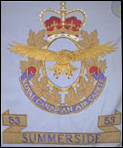
 |
 |
||||||||
|
||||||||
 In September of 1941, a group of citizens met in the Town Hall to discuss the formation of a local squadron. A.R. (Arthur) Brennan, as president of the Board of Trade, had attended a meeting in Halifax where details of the air cadet program were explained. It was moved by J.E. Dalton, seconded by Lloyd Gorrill, and carried unanimously that a local unit be established. At a meeting a week later, a Citizen's Committee of fifteen men was given the power to carry out the inaugural work.
In September of 1941, a group of citizens met in the Town Hall to discuss the formation of a local squadron. A.R. (Arthur) Brennan, as president of the Board of Trade, had attended a meeting in Halifax where details of the air cadet program were explained. It was moved by J.E. Dalton, seconded by Lloyd Gorrill, and carried unanimously that a local unit be established. At a meeting a week later, a Citizen's Committee of fifteen men was given the power to carry out the inaugural work. In the summer of 1943, a number of the cadets attended a camp at the Charlottetown airport. In August 1945, No. 1 R & NS held a two-week course for cadets around the Maritimes. The local unit held annual inspections, attended church parades as well as Remembrance Day parades and ceremonies, and continued to thrive. In September 1944 about 75 boys signed up for the program through the Summerside High School.
In the summer of 1943, a number of the cadets attended a camp at the Charlottetown airport. In August 1945, No. 1 R & NS held a two-week course for cadets around the Maritimes. The local unit held annual inspections, attended church parades as well as Remembrance Day parades and ceremonies, and continued to thrive. In September 1944 about 75 boys signed up for the program through the Summerside High School.